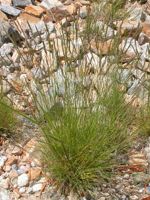Mon-Fri 9am - 5pm Mountain time
Purple Prairie Clover vs Idaho Fescue
Dalea purpurea
Festuca idahoensis
NOT AVAILABLE THIS SEASON - MIGHT RETURN
CUSTOM GROW
Purple Prairie Clover is a native perennial wildflower known for its striking purple blooms. The flower heads grow as dense spikes on tall stems, with each flower head containing many tiny blossoms. Blooming for 4–6 weeks in the summer, it attracts a variety of pollinators, including bees and butterflies.
The high protein content of the Purple Prairie Clover makes it excellent forage for wildlife and birds like to feed on its seeds. As a nitrogen-fixing plant, it enriches the soil, improving fertility and benefiting nearby vegetation. These ecological contributions make it a great choice for pollinator gardens, prairie & rangeland restoration, naturalization, and re-vegetation efforts.
This drought and heat-tolerant plant thrives in various soil conditions, including rocky soil, making it remarkably easy to grow in challenging environments.
Idaho Fescue is a native perennial bunchgrass recognized for its fine-textured, blue-green foliage. Its dense, tufted growth and deep root system make it drought-tolerant and effective at stabilizing soils, particularly on slopes and open grasslands. Its upright, arching form and dense clumps give it strong ornamental value in both natural and designed landscapes.
This hardy grass provides cover for wildlife and forage for grazing animals, while also supporting soil health and habitat diversity. Idaho Fescue is well-suited for erosion control, ecological restoration, naturalization, xeriscaping, and habitat enhancement projects.

